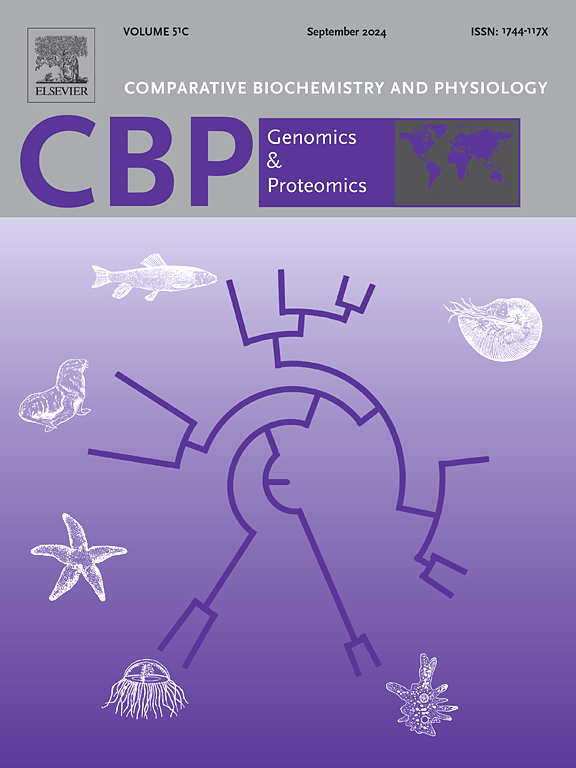The physiological and transcriptional differences between golden and brown noble scallops Chlamys nobilis
IF 2.2
2区 生物学
Q4 BIOCHEMISTRY & MOLECULAR BIOLOGY
Comparative Biochemistry and Physiology D-Genomics & Proteomics
Pub Date : 2025-03-29
DOI:10.1016/j.cbd.2025.101498
引用次数: 0
Abstract
Mollusks are the second Phylum in the Kingdom Animalia, which provide not only high-quality protein but also serves as a viewing function for humans due to the polymorphism in shell colors. However, the mechanisms of the differences in shell colors, especially on scallops, have rarely been studied. In this study, the shell and mantle of two different shell colors (golden and brown) of the noble scallops Chlamys nobilis were analyzed, including their microstructure, pigment content, and gene expression. The results showed that the golden scallop shell is golden from the outside to the inside, while the prismatic and nacreous layers in the brown scallop are lighter in color than the periostracum. Unlike the golden scallop, there was a layer of melanin vesicles at the edge of the brown scallop mantle. The total carotenoids content (TCC) in the mantle and shell of the golden scallop was significantly higher than that of the brown scallops (P < 0.05), but the melanin content was significantly lower than that of the brown scallop (P < 0.05). Candidate genes such as BCDO1, CYP5A, CYP2J, CYBA, EP300, and GNAO were screened from the differentially expressed genes (DEGs), and their differential expression may explain the differences in melanin and carotenoid content between the golden and brown scallops. These findings will help to understand the color polymorphism of noble scallops and provide a basis for further research on the inheritance of noble scallops.

金色和棕色高贵扇贝的生理和转录差异
软体动物是动物界的第二门,不仅提供高质量的蛋白质,而且由于其外壳颜色的多态性而具有人类观看功能。然而,贝壳颜色差异的机制,特别是扇贝,很少被研究。本研究对贵族扇贝(Chlamys nobilis)两种不同贝壳颜色(金色和棕色)的外壳和地幔进行了分析,包括微观结构、色素含量和基因表达。结果表明,金色扇贝外壳由外到内呈金黄色,而棕色扇贝的棱柱状层和珍珠层的颜色较骨膜浅。与金色扇贝不同的是,棕色扇贝的地幔边缘有一层黑色素囊泡。金色扇贝的地幔和壳中总类胡萝卜素含量(TCC)显著高于棕色扇贝(P <;0.05),但黑色素含量显著低于褐干贝(P <;0.05)。从差异表达基因(DEGs)中筛选出BCDO1、CYP5A、CYP2J、CYBA、EP300、GNAO等候选基因,这些基因的差异表达可能解释了金黄色和棕色扇贝在黑色素和类胡萝卜素含量上的差异。这些发现将有助于了解贵族扇贝的颜色多态性,并为进一步研究贵族扇贝的遗传提供依据。
本文章由计算机程序翻译,如有差异,请以英文原文为准。
求助全文
约1分钟内获得全文
求助全文
来源期刊
CiteScore
5.10
自引率
3.30%
发文量
69
审稿时长
33 days
期刊介绍:
Comparative Biochemistry & Physiology (CBP) publishes papers in comparative, environmental and evolutionary physiology.
Part D: Genomics and Proteomics (CBPD), focuses on “omics” approaches to physiology, including comparative and functional genomics, metagenomics, transcriptomics, proteomics, metabolomics, and lipidomics. Most studies employ “omics” and/or system biology to test specific hypotheses about molecular and biochemical mechanisms underlying physiological responses to the environment. We encourage papers that address fundamental questions in comparative physiology and biochemistry rather than studies with a focus that is purely technical, methodological or descriptive in nature.

 求助内容:
求助内容: 应助结果提醒方式:
应助结果提醒方式:


